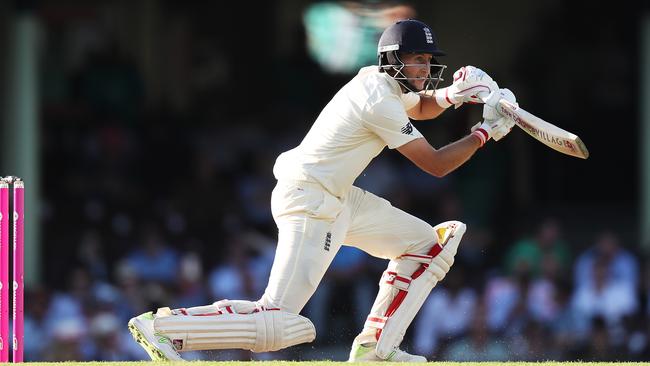Ashes fifth Test: Difference between Smith and Root defines series
Joe Root’s departure late in the day left a sense of a job not done.

Before this fifth Test, Joe Root mused arithmetically that the difference between the teams during these Ashes had been Steve Smith: “Take his runs out of it and we’ve been there or thereabouts to win.”
More meaningless than obvious, or vice versa? Reminiscent certainly of that old gag about the anatomical difference between your aunt and uncle. The point might also have been more sharply made as the difference between Smith and Joe Root.
As vice-captains in 2015, the pair split nearly 1000 runs, compiling two centuries apiece, in winning causes each time. They stood for both present and future, storied careers of Ashes rivalry almost foreordained.
Thirty months, however, have changed that rivalry’s dynamic. In 2015, his team’s victory made Root the obvious recipient of the Compton-Miller medal for player of the series; this summer’s medal has surely already been sent for engraving with his counterpart’s name.
Coming into the Sydney Test, Smith had made more than twice the runs of Root at four times the average. The Australian’s three hundreds, moreover, had been defining, while the Englishman’s three fifties had been arrested developments, which his career in a general sense, with a single century in his past 18 innings, has started to look also.
What was left for Root yesterday could only be the slightest redress. It began favourably with his winning the toss; it threatened to go awry when 2-85 quickly became 3-95, at which point Root was a tentative five. Soon after, with two men back, he took on a short ball from Josh Hazlewood and was harried and hurried into a hook.
It was the kind of early counterattacking shot of which Root has made a speciality in 2015. It was the kind of slightly inattentive stroke that cost Root his wicket in Melbourne last week.
For an instant, Root’s innings, perhaps even his career, hung with that top edge — when it bisected the fielders, he looked suitably penitent. He had faced 50 deliveries before taking advantage of some width from Mitchell Starc to drive through the covers with that signature of the right knee on the ground. He acknowledged applause for 50 perfunctorily, job not even half done.
This was Root’s first Test in Sydney, where four years ago he became part of England’s Ashes debris. There was a sense in which his innings here was about four years hence — the opportunity to captain England in Australia again being one he has admitted to coveting, to take advantage of the lessons he has learned this summer.
As an application, it was destined to remain incomplete, curtailed by the second new ball.
Boundaries came from Starc’s first two deliveries, a booming drive, a sketchy edge; the third, an inviting leg stump half-volley, was loosely clipped, well caught and forlornly rued; and so a 19th innings elapsed without three figures.
It was hard to be too critical: Root will have hit countless shots like it, and executed them flawlessly. But when England lost Jonny Bairstow in the next over, the day’s last, much of England’s hard work was squandered.
What chance Root’s second opportunity to lead in Australia? He has had some harsh reviews, notably Ricky Ponting’s asperities after the Perth Test, that Root captained England like “a little boy”; that he was “really quiet and too shy to say too much”.
Truth be told, a losing captain is pressed to say very much at all, beyond falling back on tired lines about “working hard” and “moving forward”. At his last press conference, Root sounded less like a boy than a bureaucrat, foreshadowing changes in “the seam-bowling department” and “the spin department” as though he had come from HR to pin a note to the bulletin board.
The fact is, too, that much about Root’s captaincy future lies, while it’s wearisome to repeat it, in the hands of the Crown Prosecution Service. The gap left by Ben Stokes’ absence has only grown on this tour; probably some time during the one-day series, when the CPS is tipped to make public its decision, it may gape still further. In that respect, 2021 seems a very long way off.
It was at times a day’s hard work for Australia, on a pitch whose green flecks seemed to be fading under the warm sun by the over. There was an edge off the bowling and flaws in the out-cricket, an opportunity to run out a ball-watching Dawid Malan going astray. Pat Cummins toiled nobly in his first Test appearance on his home ground, and after nine consecutive Tests is in uncharted physical territory.
For Australia, though, it should have been harder still. And were you looking for reasons the hosts have come out ahead in this series, you might observe that England’s top three have remained unchanged despite passing 60 twice in the entire series.
James Vince will commence his 20th innings with two Test half-centuries to show for it.
He provided the usual indicators of quality and occasioned the standard pangs of disquiet: flails through cover and over point to take him into the nervous teens; a commanding pull shot to push the needle into the red of the mid-20s, and it is unnecessary to report further.
It’s almost as though Vince has never been advised that it’s permissible to bat for longer: one would write more about him, but he never leaves any more to say.
It’s more than runs compiled in this series that have decided it; it is also runs forgone.



To join the conversation, please log in. Don't have an account? Register
Join the conversation, you are commenting as Logout